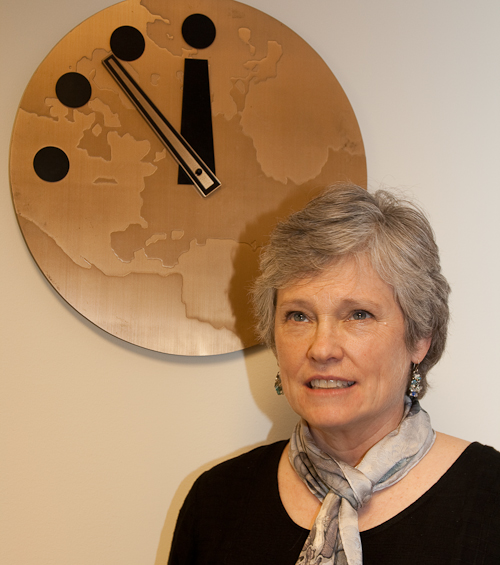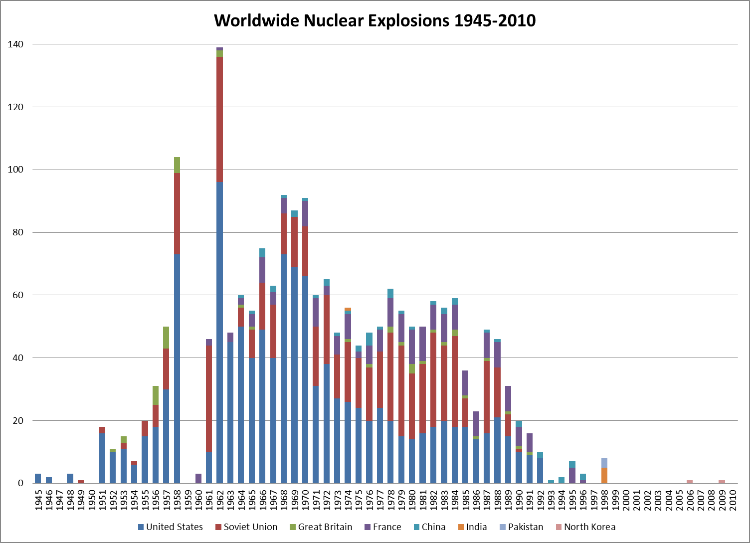
Dr. Kennette Benedict, Executive Director and Editor of the Bulletin of Atomic Scientists, and the Doomsday Clock. Photo: Olivia Fermi © 2010.
“When I see injustice it makes me mad,” says Dr. Kennette Benedict. She works under the constant reminder of a clock, but it’s not tracking her hours.
A group of visionary atomic scientists conceived the Doomsday Clock in 1947 as a way to measure the clear and present danger of global annihilation from atomic weapons. This peril is symbolized as midnight on the clock. Its hands have hovered between two and twelve minutes to midnight from inception to today.
For over fifty years, the Doomsday Clock has been an ever-present reminder to all of humanity of the need for complete global cooperation to control and ultimately to eradicate nuclear weapons from Earth.
Russia and the United States detonated atomic bombs from the second half of the 1940’s through the early 1990’s. The bomb blasts were called tests. Each nation felt threatened by the other and each nation strived to beat the other with ever more powerful and impressive demonstrations of nuclear capability. This was the Cold War.
To a lesser extent, the U.K., France and China also participated in the Cold War by performing their own atomic bomb tests.

Worldwide Nuclear Explosions 1945-2010. Source: Wikimedia Commons. License: Creative Commons Attribution-Share Alike 2.5 Generic.
Albert Einstein, Linus Pauling, Leo Szilard, Hans Bethe and a group of nuclear physicists initially set the hands of the Doomsday Clock at seven minutes to midnight and issued a manifesto. The physicists together with other concerned citizens formed The Bulletin of Atomic Scientists to encourage the establishment of international controls on nuclear weapons for world peace and security.
Today, against the hope of its founders, the Doomsday Clock keepers found it necessary to set the Clock’s hands at six minutes to midnight. The Bulletin’s manifesto remains as potent as at publication in June, 1947:
“A Statement from the
Emergency Committee of Atomic Scientists
These few facts are accepted by all scientists:
1. Atomic bombs can now be made cheaply and in large numbers. They will become more destructive.
2. There is no military defense against atomic bombs, and none is expected.
3. Other nations can rediscover our secret processes by themselves.
4. Preparedness against atomic war is futile and, if attempted, will ruin the structure of our social order.
5. If war breaks out, atomic bombs will be used, and they will surely destroy our civilization.
6. There is no solution to this problem except international control of atomic energy and, ultimately, the elimination of war.”
Although the Clock’s hands remain perilously close to midnight, the Bulletin’s summary of the global security situation in 2010 has evolved since 1947: “International cooperation rules the day. Talks between Washington and Moscow for a follow-on agreement to the Strategic Arms Reduction Treaty are nearly complete, and more negotiations for further reductions in the U.S. and Russian nuclear arsenal are already planned. Additionally, Barack Obama becomes the first U.S. president to publicly call for a nuclear-weapon-free world. The dangers posed by climate change are still great, but there are pockets of progress. Most notably: At Copenhagen, the developing and industrialized countries agree to take responsibility for carbon emissions and to limit global temperature rise to 2 degrees Celsius.”
One of the Doomsday Clock keepers is Kennette Benedict, Executive Director and Editor of the Bulletin of Atomic Scientists. I asked Dr. Benedict, a former Director of International Peace and Security at the John D. and Catherine T. MacArthur Foundation, “what keeps you going when you see problems in the world escalating?”
“Nuclear weapons are such terrible weapons. Really they are weapons of mass destruction and so few of us get to make any decisions about them. This seems totally unfair and unjust.
“That some countries can have nuclear weapons and others can’t seems the height of hypocrisy to me. It makes no sense in the world — especially in the US where we abide by laws and we believe in some kind of equity and fairness — with almost 6,000 deployed nuclear weapons. That’s enough to destroy human life many times over.” Russia has approximately 4,600 operational nuclear weapons and the two nations together currently hold 95% of the atomic weapons in the world.
“The helplessness the rest of us feel at the prospect, without any ability to say ‘No’ or to be heard — that’s what motivates me.”
When Benedict started at The Bulletin four years ago, she helped instigate a reinvention of the organization’s public image. People perceived The Bulletin as focused solely on the arms race. “But,” explains Benedict, “we had been publishing on a range of issues since almost the beginning — the environment, resource scarcity, poverty.”
She continues, “when I came, I wanted to highlight the broad interest in how human beings are living on the Earth — either in harmony or not. We take the idea of doomsday seriously — what other things besides nuclear weapons could cause civilization and life as we know it, to come to an end?”
Consequently, the new website has four areas of focus: nuclear weapons, nuclear energy, bio-security and climate change. “These are all technologies which can come back to bite us,” says Kennette. She knows readers treasure the Bulletin’s in-depth articles and web posts about complex issues because the expert, non-technical styles.
“For me personally, it’s also about having a vehicle to express dismay and frustration and then also to talk about solutions. The Bulletin is a good fit for me. I want to point out the perils of nuclear weapons as vividly as I can.”
Hearing Kennette’s dedication and knowing of her persistence on these issues, I couldn’t help wondering if their were some influences from her childhood that led her to become a contemporary keeper of the Doomsday Clock and spokeswoman for nuclear disarmament.
“My parents were activists working in East Harlem, New York City. My dad was a Minister who believed in social action ministry. If you were going to help the poor you lived with the poor.” The family went on to Cleveland where her father worked with poor of Appalachia moving into the city. When she turned seventeen, they moved to Chicago and her father helped Blacks in the South Side through his church affiliations.
“My dad resisted the draft in World War II,” says Kennette. “Because he was a seminary student, he didn’t actually have to enlist.” But it went deeper than that. “My dad and his classmates thought the draft was based on class privilege. ‘We shouldn’t get out of it because we’re seminary students.’”
Ford Motor Company was still operating its plants in Nazi-controlled Germany. “Until all the US businesses pulled out of Germany, they didn’t see why young boys should be sent over to fight the Germans. Eight of them went to prison for a year because they didn’t sign up, and they didn’t use their exemption.”
“It’s in my DNA,” says Kennette.
* * * *
A renewed push toward global zero for nuclear weapons is gaining strength. Check out: Global Zero where you can add your name to a declaration signed by world citizens and world leaders; The Wise Men and The Bomb and Countdown to Zero.


 Twitter
Twitter
Pingback: The Doomsday Clock